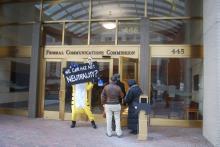
Jonathan Chambers from Conexon works with rural electric cooperatives as they bring high-quality Internet access to rural America. When he spoke with Christopher for episode 229 of the Community Broadband Bits podcast last November, he had some choice words to say about how the FCC chose to continue to subsidize big telcos for little return.
They Propose "A Huge Mess"
In a recent post on the Conexon blog, Chambers analyzes “The New Trumpfone Program,” and reveals how proposed Connect America Fund (CAF) subsidies, when applied to real world data, creates outrageous financial waste. While providers can receive up to $17,500 per location in CAF funding, when applied to a per subscriber formula, the figure is $100,000:
There are no U.S. communities where satellite or fixed wireless provides broadband to 100% of the homes and small businesses. Not 80% either, which is the FCC assumption. Not 50% or 25% or 15% or 10% or even 5%. The FCC has data on this. Let’s say, for this arithmetic exercise, that a satellite or fixed wireless subscriber achieves a 15% market share of telephone and broadband service in a rural community.
A 15% market share while receiving $17,500 for every location in an area translates into over $100,000 per subscriber. Should there be insufficient competitive pressure in the auction, the $17,500 per location is a realistic outcome, as is the likelihood of $100,000 per subscriber by some technologies.
Reimburse Per Subscriber
Chambers offers a sensible solution to save CAF funds and direct public dollars in the right direction: reimburse providers for actual subscribers, rather than by location.
The most perverse subsidy incentive is one by which a provider makes more money by not serving customers. That’s the current FCC plan and the basis of many current FCC subsidies. By definition, the high cost subsidy is based on how much a provider is calculated to lose per customer. When the FCC provides funding by location, rather than by subscriber, some technologies will make more money by winning the auction, collecting public funding, and serving no one. Hence the fallacy of the argument that it is less expensive to cover rural America with certain cheaper and less capable technologies. If rural America doesn’t subscribe to the less capable services, then the FCC is adopting a classic penny-wise-pound-foolish program.
Having worked with rural cooperatives, Chambers and Conexon have learned the same thing we have - that rural American want access to the same high-quality connectivity available in urban centers. It’s an incorrect and insulting stereotype that people who live in the country don’t want fast, affordable, reliable connectivity when in today’s economy geographical distance necessitate the ability to go far online.
Let The People Decide
If subscribers were able to control where their share of CAF funding flowed, waste and an incentive to leave out certain rural areas would dramatically decline. Chambers recognizes the power of local subscriber choice and, in this case, it would put a realistic and multi-dimensional value on that $100,000 Trumpfone:
The elegance of this solution is that it relies on people who live and work in rural America to choose their broadband future. It permits multiple technologies and providers to compete for customers, rather than rely on a company’s lobbying strength. It permits the evolution of technology, rather than consign rural America to today’s level of technology. It saves the public money, because it would use the current FCC budget applied to subscribership, rather than total covered locations. Most important, it would unleash private investment now, rather than delay yet again this portion of the Connect America Fund while the FCC begins a multi-year auction process.
Read the full story on the Conexon blog.







